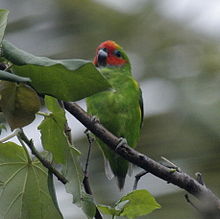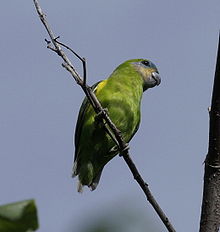- Double-eyed Fig Parrot
-
Double-eyed Fig Parrot Male C .d. marshalli Conservation status Scientific classification Kingdom: Animalia Phylum: Chordata Class: Aves Order: Psittaciformes Family: Psittacidae Tribe: Cyclopsittacini Genus: Cyclopsitta Species: C. diophthalma Binomial name Cyclopsitta diophthalma
(Hombron & Jacquinot, 1841)The Double-eyed Fig Parrot Cyclopsitta diophthalma, also known as the Blue-faced Fig Parrot, Red-faced Fig Parrot, Dwarf Fig Parrot, and the Two-eyed Fig Parrot, primarily inhabits forests on New Guinea and nearby islands, but is also found in isolated communities along the tropical Australian coast, east of the Great Dividing Range. With an average total length of about 14 cm (5½ in.), it is the smallest parrot in Australia.
Most subspecies of the Double-eyed Fig Parrot are sexually dimorphic, with males having more red (less silvery and blue) to the face than the females. It is predominantly green with a very short tail, a disproportionately large head and bill, and red and blue facial markings. Its name is derived from the cheek patches of some subspecies that vaguely resemble eyes.
Although assessed as of Least Concern by the IUCN, certain subspecies are under threat. Coxen's Fig Parrot (C. d. coxeni) is of one Australia's rarest and least known birds, having been recorded on fewer than 200 occasions since being described by Gould in 1866. It is classified as Endangered in Queensland (Nature Conservation Act 1992), New South Wales (New South Wales Threatened Species Conservation Act 1995), and also nationally in Australia (Environment Protection and Biodiversity Conservation Act 1999) as it has declined due, at least in part, to the clearing of lowland subtropical rainforest over its range.
Contents
Behaviour
The Double-eyed Fig Parrot generally forages for figs, berries, seeds, nectar, and the grubs of wood-boring insects. This foraging is done in pairs or in a flock of only a few individuals. It tends to fly in a quick and direct manner. It produces a short and shrill call. Unlike many other parrots which generally use existing holes in trees for nests, Double-eyed Fig Parrots excavate their own nest cavities, usually in a rotten tree.
Double-eyed Fig Parrots utter high-pitched, clipped, two or three note zzzt-zzzt or zeet-zeet calls, unlike the rolling or trilling screeches typical of lorikeets. These calls are mostly made in flight, but sometimes when perched. When engrossed in feeding, it may also make a variety of softer, chattering noises.
Subspecies
Female C. d. marshalli from the Cape York Peninsula, Australia
 Female C. d. macleayana in Cairns, Queensland, Australia
Female C. d. macleayana in Cairns, Queensland, Australia
There are eight described subspecies of the Double-eyed Fig Parrot. The first five are restricted to New Guinea and associated islands; the last three are restricted to Australia.
- Cyclopsitta diophthalma diophthalma
- Cyclopsitta diophthalma coccineifrons
- Cyclopsitta diophthalma aruensis
- Cyclopsitta diophthalma virago
- Cyclopsitta diophthalma inseparabilis
- Cyclopsitta diophthalma marshalli (Marshall's Fig Parrot)
- Cyclopsitta diophthalma macleayana (Macleay's Fig Parrot or Red-browed Fig Parrot)
- Cyclopsitta diophthalma coxeni (Coxen's Fig Parrot)
References
- BirdLife International (2004). Cyclopsitta diophthalma. 2006. IUCN Red List of Threatened Species. IUCN 2006. www.iucnredlist.org. Retrieved on 06 May 2006. Database entry includes justification for why this species is of least concern
- Queensland Government website: <http://www.epa.qld.gov.au/nature_conservation/wildlife/native_animals/doubleeyed_figparrot_coxens/>
- Recovery Plan for the Coxen's Fig Parrot Cyclopsitta diophthalma coxeni (Gould), New South Wales National Parks and Wildlife Service, July 2002
- The Parrot Society UK: <http://www.theparrotsocietyuk.org/conarticle6.shtml>
External links
- World Parrot Trust Parrot Encyclopedia - Species Profiles
Categories:- IUCN Red List least concern species
- Birds of Australia
- Cyclopsitta
- Birds of New Guinea
Wikimedia Foundation. 2010.



